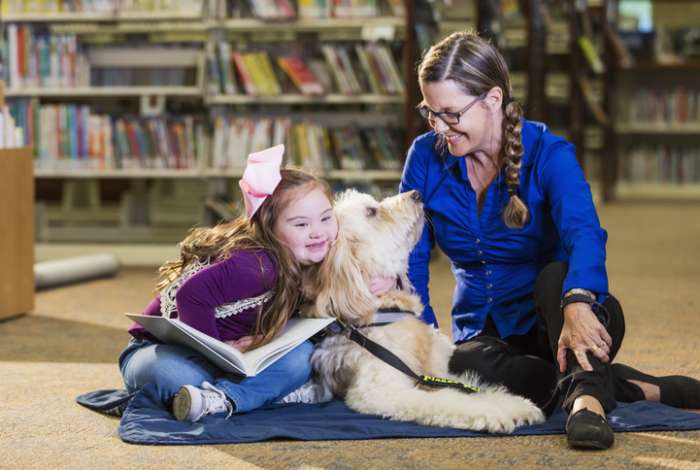If you think your special needs child can benefit from animal therapy, you may be on to something!
Many pediatric social workers and licensed therapists strongly believe that spending time with animals can be beneficial for children with special needs or disabilities.
Animals that tend to be “popular” with kids--such as dogs, bunnies, and horses--can provide a calming influence on children, reducing their anxiety and stress levels. Children with autism and/or ADHD may even find that spending time with a beloved animal gives them a sense of purpose; and helps with sensory issues.
In this feature, two licensed therapists outline the benefits of therapy animals for special needs kids and share ways you can find the “perfect match” therapy animal for your child.
Related: Therapy for Teens: Does My Teen Need a Therapist?
What are animal therapy animals for kids?
The definition of animal therapy animal can vary, but according to licensed therapist Adam Clark, LCSW, AASW, C-PD, “Therapy animals are animals that have been trained alongside a licensed therapist or helping professional.
Animal-assisted therapy activities (AAT) involve using animals, such as dogs or horses, in therapy sessions with kids to process and work through their emotions and behavior
The Autism Spectrum Disorder Grief Cycle
The Autism Spectrum Disorder Grief Cycle Shock and disbelief. The first reaction a parent usually has when hearing the diagnosis, even if they suspected something was wrong, is disbelief. Read More
You will hear definitions of ‘therapy animals’ that include volunteer groups, but these cases are better defined as animal-assisted activities or animal-assisted education, than therapeutic interventions,” he explains. “Many times, the presence of an animal holds an inherent therapeutic benefit.”
From a mental health perspective, A therapy animal is trained and evaluated for its ability to thrive within its environment. For instance, therapy dog training for hospice care needs similar behavioral certification to ‘canine good citizen and additional training to be comfortable in hospital and nursing home settings.
In a traditional sense, adds Clark “Animal therapy interventions can include the therapist who is also handling the animal, or the therapist and an animal handler.”
Differences between therapy animals, emotional support animals, and service animals
A therapy animal may be used in the process of therapy. “Equine therapy is an example: You use the horse, which does not have any special training, but the therapist has the training, and they simply use the horse as part of the intervention,” explains Baron.
An emotional support animal “helps someone work through issues like anxiety or another problem, and they provide a source of comfort and stability and have a calming effect on the owner.” According to Baron, “These animals also don’t really have any specific training.”
Service animals, on the other hand, “are trained for something specific, a specific intervention, it can be alerting someone of a seizure, putting themselves in the way of something to protect the owner, opening doors, a whole number of things, to protect the owner.”
Adds Clark, who acknowledges therapists worldwide may differ on the specific definitions: “Emotional support animals are 'prescribed' or recommended by a licensed professional to a specific animal that typically lives with someone with a diagnosed mental health condition.”
He explains these animals should also be behaviorally evaluated and emotional support animals do not have the same regulations in public settings that service animals do.
“Service animals are highly and professionally trained animals to support individuals with tasks related to an official disability and have federal protections through the Americans with Disability Act.”
Why Animal-assisted therapy is gaining momentum in schools

Life can be complex enough for kids with disabilities. Anything that can help them feel calmer and supported is wonderful - this is why Animal-assisted therapy is strongly encouraged for those with autism, as well as those processing traumas.
In fact, in some elementary schools, therapy dogs will come to visit students with autism and ADHD; and the kids look forward to their schoolroom visits. They’ll make the connection that service dogs are not only fun to pet and cuddle with, but they help lower students’ blood pressure and assist with their communication skills.
My own daughter loves when a therapy dog (a Yellow Lab) visits her classroom every few weeks. My daughter has developmental disabilities and even being around animals, such as therapy dogs and service dogs, lowers her energy levels and makes her feel calm and emotionally centered. I love that my daughter’s school district in New York encourages Animal-assisted therapy.
I’ve even heard of programs in which kids with special needs “read” to dogs at a shelter; programs like this make therapy sessions for kids extra cuddly and cute, but also improve a child’s self-confidence and self-esteem.
Benefits of Animal-assisted Therapy for Kids
Animal therapy can also provide many benefits to children with special needs or disabilities. Some benefits from Animal-assisted therapy include
- Improving kids’ mental health and anxiety
- Helping boost better communication skills
- Supporting kids’ emotional and social needs
Therapy animals have been used to help kids with a variety of conditions including, autism social anxiety, learning disabilities, and emotional development delays.
What are the benefits of therapy animals for autism?
Animal-assisted therapy has been shown to be an effective treatment for children with Autism Spectrum Disorder (ASD). According to Mendi Baron, LCSW, Founder and CEO of Moriah Behavioral Health: “Animal therapy enables people who struggle with verbal communication in talk therapy – whether they have special needs, are developing children, or for other reasons – to process issues in a nontraditional way.”
Can therapy animals and service animals help with social anxiety?
Animals can help a person with their emotions, anger management, and anxiety, and be a support for those with physical disabilities as well, explains Baron, who specializes in mood, anxiety, and behavioral disorders.
“Animals can also assist with social interaction and be a source of encouragement to help push someone out of their comfort zone,” adds Baron, who owns a service dog. “I had a young female client with extreme trauma who couldn’t work through it or express herself. Working with a horse allowed her to (be able to) eventually talk about things,”
Oftentimes, service dogs like Baron’s, “benefit people who suffer from anxiety or aren’t able to communicate their needs in situations. It’s therapeutic to have something to touch or hold and it calms them down.”
Does Animal-assisted therapy help with emotional regulation?
Dr. Clark has also seen the benefits of horse and dog therapy with kids in improving their emotional regulation and communication skills. He observed children “who felt incapable of standing up for themselves” interact with therapy horses.
These horses helped the children “learn boundaries and say ‘no’ by watching and learning how horses do it in their own way. I've also watched children co-regulate with dogs when their adrenal system activates and learn through deep breathing and petting a therapy animal in a safe manner how to process difficult emotions and find greater emotional safety.”
Even kids with more serious mental health conditions can benefit from Animal-assisted therapy. “Animals can help a person navigate a manic episode, a feeling of disorientation or just feeling like they are out of control,” explains Baron. “An animal can help to re-orient them or calm them down. The animal can even offer potential life-saving benefits.”
How can animals help kids with special needs and learning disabilities?
According to Baron, there are situations where someone with Tourette’s Syndrome, or tics, for example, may want to bang their head on the wall or the floor “and their dog will place themselves between their head and the surface to protect them and make sure they’re safe.”
Baron’s daughter has Down Syndrome “and we have a therapy dog who senses when she has trouble communicating. The dog is a true companion. When my daughter was learning to crawl, the dog mimicked crawling to teach her how to do it.”
Adds Baron: “There are numerous situations where the dog offers sensory experiences with touch, as well as social opportunities for her.”
How animals help improve kids’ well-being and quality of life
Clark points out there’s a natural calming effect with oxytocin release when petting animals. “Animals can support 'normalizing' situations in places or situations that are fearful for people.” Clients, especially children, “can learn about empathy, care-taking, and safe decision-making with a therapy animal partner in the session.”
Animals can also make special needs kids feel safe. “They can provide a supportive buffer in strange situations or when a child is being asked to engage with someone they don't know,” says Clark. “It's always important to remember the ‘goodness’ of fit for both the child and animal in all situations.”
How to find the right therapy animal for your needs
Finding the right animal match greatly depends on the child’s issues and concerns, the child’s personality, and what they can handle, shares Baron. “For me, the type of dog that works is a Husky. They’re smart, stubborn, not aggressive, and have a lot of energy.”
Baron will walk with clients and hand them the dog’s leash. “They learn to be assertive and keep control of the dog because if you don’t take control of it, it will push you. But the animal makes them feel comfortable so they talk more, and it seems to work particularly well with teens.”
Now if, for example, you have a child with a physical disability, they might want a smaller dog or animal, it could even be a rabbit. “It really comes down to what’s best for the child and matching the personality of the animal with the needs and tolerance levels of the child.”
There are many organizations that help partner you with the right service animal for your situation. Baron recommends the Assistance Dogs International website as a great place to start.
Can you train a pet to become a therapy animal?
Both pets and therapy animals offer different benefits for children. But if you already have a family pet your child is close to and believe it might be trainable, you can also reach out to an accredited nonprofit like Love on a Leash or The American Kennel Club to see if they might be able to train your pet to be a service animal.
“It’s a coalition of nonprofits that train and place animals. Their website has lots of good information about what to look for in a reputable trainer, and they also have a certification program for members.”



